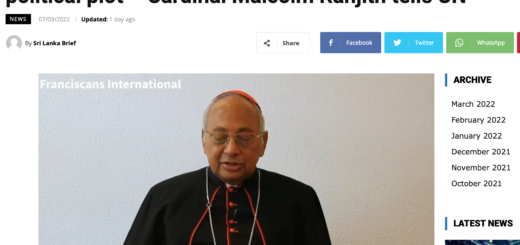Stalin’s teachers don’t want to wear saree/osariya

On 21st November 2022 a handful of teachers & principals arrived wearing casual clothing instead of sarees. Ceylon Teachers Union (representing over 50,000 teachers) VP Rasika Handapangoda claims there have been social media campaigns encouraging teachers to replace the saree. This is a clue as to the mischief at play and provides answers to many doubts. Teachers have been wearing the saree/osariya since 1930s – why should it suddenly become a problem in 2022? Breakdown of discipline is dangerous to a country & has detrimental consequences – what if doctors or nurses decide their attire is uncomfortable, what if the police or armed forces claim the same? Is a country to put up with such antics? No country will – why should Sri Lanka. There are 4.1million students in over 10,000 schools with close to 250,000 teachers of whom 73% are females.
The Education Minister Susil Premajayantha categorically stated that the dress code of female teachers would not be revised. If teachers have chosen to defy such orders, then the Minister has to take action. This is setting a bad example and inaction means, teachers may resort to even changing teaching curricular and this will impact the future generations of youth.
Government schools follow a system – teachers wear sarees and school children wear white uniforms. That has been the dress code for decades. No teachers complained of the saree being an “uncomfortable” attire – so why suddenly now? Is this a new movement to shed the cultural attachment to the traditional dress? Did teachers start travelling by bus only recently? How many people travel in the bus wearing sarees – even corporate sector employees!
Dress code is nothing that is up for debate. We should not be bothered about what camp wants saree or what camp doesn’t. What matters is that there is something called discipline – which is applicable not only to children but to the teachers & principals as well. If the adults are not disciplined how can they discipline the children?
The lame excuse is to always plug how teachers in other countries dress. The day we have everything that is found in other countries, then we can compare our country with that country, just nitpicking one or two things and trying to plug into Sri Lanka’s context is wrong. Besides, there is a culture and tradition that is associated with Sri Lanka. This is what draws tourists and becomes a major component of our foreign reserves. Sri Lanka has an identity which must be protected. The saree was always considered a symbol of nationalism. Obviously these new trends and campaigns are aimed at removing the cultural identify of Sri Lanka & to denationalize Sri Lanka. Remember how the residential schools in Canada denationalized the indigenous of their cultures and traditions, forcing them to dress in western attire! Soon the national anthem may be not fashionable enough & a campaign may emerge to sing God Save the King or the Star Spangled Banner.
Why do some western diplomats go an extra mile to wear saree as a gesture of goodwill? Why do tourists wish to marry in Sri Lanka wearing the traditional saree?
Why do our female diplomats wear the saree proudly as they represent Sri Lanka?
Why are our traditional weddings in saree/osariya?
While we market our culture for tourism, there are some trying to push Sri Lanka to denounce their cultural heritage. What is the sinister plan behind this?
While Joseph Stalin the male is concerned about teachers removing the saree, he is mum about Muslim teachers removing their abaya. While foreign funded campaigns have got non-Muslim teachers to play truant, we don’t see Muslim teachers removing their abaya. This is discipline and respect. Discipline means we follow the rules, whether we individually like them or not. Discipline is applicably not to an individual alone but collectively, that is why we are bound to respect the rules. Many of these arguments are being supported by biased surveys that have questions framed to denounce sarees & replace with western attire. Who are in a hurry to remove cultural identity of Sri Lanka & replace with western attire/identity?
Sri Lanka’s education system provides for 13 years of compulsory education. Primary education lasts 5 years, Secondary education lasts 6 years and advanced level 2 years. Schools start at 0730 and ends at 0130 where unlike public servants, teachers too dart off home and teachers unlike rest of the public service remain at home throughout the school holidays. The manner the saree/osariya is to be worn by teachers should be clearly defined too. It is unfortunate that teachers have to be taught how teachers should wear the saree when teachers are expected to teach right from wrong.
Teachers wearing saree is an identity as a teacher and they command respect. Formal clothing like the saree affirms a social distance, an authority and status over the students. Casual clothing on the other hand provides a more on par status. However, our system of education follows the culture of respect to elders not an on par status. The behavior of teachers results in students lacking respect for the teacher.
Teachers are responsible for educating students – education means not only reading and explaining text books. Whatever new methodologies used, the primary role of a teacher is to nurture a child to become a good citizen equipped with learning that is not confined to the classroom alone. A teacher plays a key role in building citizens and citizenship. Schools are centres of lifelong learning. What a child picks up from home or school, that child carries forward into adulthood. Therefore, a teacher has to place the child above his/her inherent needs. This is why teaching is one of the most challenging yet respected career choices – vital for the social, cultural and economic health of a Nation. Picking saree to destroy this role is what is being questioned.
While teachers or unions seem unbothered to address the ills that take place in schools where they are directly responsible, they appear more bothered about how comfortable they dress. This is unacceptable. We can recall how teachers were lured to strike no sooner covid struck and the entire country was facing hardships. Such irresponsible behavior has to be condemned. When economic difficulties post-covid were impacting children especially those who had no means to afford smart phones or wifi-to study, not many teachers came forward to provide solace to the poor students, but they are ever ready to take to the streets to strike & demand change of clothes and now some are coming out to give aragala speeches!
With covid, lockdowns and changes taking place around the globe, teachers and the education system are expected to come up with workable solutions for Sri Lanka’s children – have they? Have they spent time to address the difficulties children have, have they taken up issues with the authorities, have they brought to the attention of parents & education ministry the many ills that are taking place amongst youth or are they more bothered about throwing the saree away. Do they counsel students, do they help solve problems students undergo with studies? While some want to plug how teachers dress in western nations, why are they reluctant to follow the learning methods of these western teachers, who do not run home, who stay back & prepare lesson plans for the next day, who keep slow learners and take pains to teach them, who monitor the students etc.. how many of Sri Lanka’s teachers follow these good practices? Simply to win arguments, it is unfair to pluck attire of teachers in western nations and plug it into Sri Lanka’s context without applying the teaching methodologies that they practice.
With changes happening around the world, it is important for Sri Lanka’s teachers to seriously address the brain-drain and respond to what changes need to take place to ensure our children do not lag behind and follow the path of memorizing notes and writing answers only to satisfy the teacher as that is all that the teacher knows. Teachers too need to be as well informed about the world and not merely the knowledge around the textbook that the teacher knows from head to toe.
When the saree has been worn for almost 100 years – it is more than strange that a man called Stalin thinks the saree should be removed and social media campaigns incite some teachers to defy the cultural norm of wearing saree to school.
The Govt cannot take this errant action lightly and ultimatums must be issued to such teachers. Either they resign and teach in places where western attire is allowed or they return to the saree. If action is not taken these same funded campaigns will next target school children and make them give up their school uniforms and come to school in what they like. This trend if allowed to go to other compartments of the government will break down law & order in Sri Lanka, this cannot be allowed.
One of the main reason for Sri Lanka’s decline is the lack of discipline and the lack of duty where people only seem to demand rights instead of being asked what they have done to the nation to demand such rights.
Teachers must set an example – they are role models for children, when they defy customary dress code, it is a stepping stone to many ugly outcomes which mischief makers are plotting behind the scenes. That education authorities have not taken action goes to show the influence being exerted from within. If teachers find wearing sarees “uncomfortable” they can give up their profession and do something else. By their action they have displayed they are unsuited to teach. Their role is a collective model role & one that does not cater to their personal whims. If this is a problem for some individual teachers – they are welcome to leave the profession. They are teachers for a reason – if they cannot fulfill that role, there is no point in tax payer money being spent on them.
Shenali D Waduge





